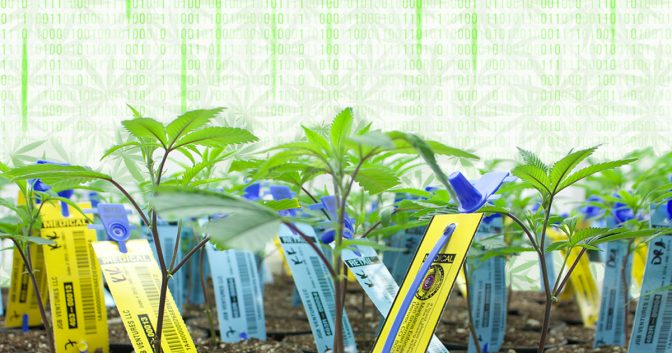Seed-to-Sale Tracking: How It Works

RFID chips (for Radio Frequency Identification) do as their name implies: They identify the plant, the package of bulk flowers, and the pre-rolled joints, edibles and concentrates made from the flowers. Because the numbers are related to one another, it’s possible to trace a pre-rolled joint back to the plant from which it came.
1. Each marijuana plant being grown by a licensed grower is given a unique identifying number that’s at least 16 digits long, which is recorded onto an RFID chip.
2. Information about the plant, such as strain name, cultivation techniques and yield, is recorded by the growers and input into a database.
3. These databases reside on the “cloud,” which really just means an off-site server. This allows growers, as well as state agencies, to check on plants remotely.
4. The flowers harvested from a plant are given a unique identifying number that’s related to the plant’s unique ID, as are the leaves and the waste matter, such as stems. Those numbers are recorded onto the chips, which are then attached to containers holding the flowers, leaves or waste matter.

Databases reside on the “cloud,” which really just means an off-site server.
5. Information about the flowers, leaves and waste matter is recorded onto a database. That information includes weight, results of potency and contaminant testing, end use, and any other data that may be required by regulators, including disposition of the product. (For example, whether it will be packaged and sold to consumers as is, processed into another form by the grower, or sent to another commercial entity for processing.) As with any database, the unique identifiers that are assigned then allow the flowers (and leaves and waste matter) to be traced back to the individual plants.
6. The bulk material may then be divided and packaged into retail units for sale to consumers, or processed into other products such as extracts or edibles. Once again, unique identifying numbers, which are related to the original plant’s unique identifying number and to the number assigned to the harvested product, are assigned to those products.
7. Information about these products, such as price, is recorded onto these online databases all the way through to the point of sale. Because of the unique identifying numbers assigned to the finished products that go onto the shelves at retail shops, pre-rolled joints, cookies or extracts can be traced back to the original plants.
States like Washington are now putting barcodes and other tagging technologies to use in seed-to-sale tracking. The big difference, aside from the cost, is that RFID chips can literally be physically tracked, yet realistically that’s overkill. They’re not advanced sensors, they’re just ID chips—so they might be useful in case of theft, but data accuracy ultimately depends on the skill level and honesty of those entering the data.
Read about «MJ Freeway’s Seed-to-Sale Software Dilemma» here
If you enjoyed this Freedom Leaf article, subscribe to the magazine today!

